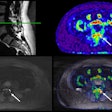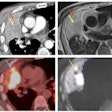SINGAPORE - Does MRI have a role in the emergency department (ED)? Perhaps, but it requires vigorous safety monitoring, according to a presentation delivered May 4 at the International Society of Magnetic Resonance in Medicine (ISMRM) meeting.
Using a dedicated MRI system in the ED offers many potential benefits, from improving access to the modality for trauma patients to offering a more certain diagnosis than other imaging modalities can, said presenter Catherine Mandel, MBBS, FRANZCR, of WA Country Health Service in Australia.
"MRI complements CT, ultrasound, and x-ray when it comes to trauma imaging," Mandel said. "And having MRI available in the emergency department means that ED patients don't have to compete with inpatients or outpatients for MRI time."
However, there are downsides to MRI in the ED, Mandel cautioned.
"MRI is expensive, staff may not have adequate work, safety issues are magnified, and ease of access may result in overuse," she said.
Mandel stressed throughout her presentation the need to ensure safety for both patients and staff when it comes to using a dedicated MRI system in the ED.
"Safety versus speed creates tension," she said. "But no MRI is so urgent that it justifies skipping safety checks."
Hospitals must develop a "safety first" culture for emergency department MRI, which should include tight access control, mandatory staff training, and vigorous screening, according to Mandel. As undertrained radiographers represent an increased safety risk, a minimum of two MRI-trained radiographers must staff the emergency department MRI suite at all times. MRI nurses and a radiologist should be onsite as well: The radiologist can handle justifying the exam, consulting with referring physicians, supporting the radiographers with safety checks, checking images while the patient is on the table, and producing exam reports.
The trickiest safety issue when it comes to MRI in the ED can be ED staff itself, Mandel warned.
"Most ED staff are not safety aware [about MR imaging], and may try to enter the scanner room [inappropriately]," she said. "There must be sufficiently trained radiology staff to avoid [injuring] people, [and that's why] MRI radiographers must be in charge in all MRI areas."
Mandel urged emergency departments with MRI to practice code blue responses, ensure that all treatment takes place outside the scanner room, and most importantly, screen staff for ferromagnetic objects every time they enter the suite. She listed some safety support practices:
- Using a dockable table
- Regularly checking patients, bedding, and staff for ferromagnetic objects
- Never assuming the MRI suite is safe from these objects
- Repeatedly checking MRI rooms for stray items
Patients who are conscious and not in significant pain can undergo routine MRI safety screening, but staff should be alert to patients who are unable to answer safety questions well due to decreased consciousness, pain, reduced cognition from treatment, language barriers, or distress.
"If patients are unable to answer [MRI safety questions, staff should make use of] next of kin, telephone interpreters, or even consider other imaging, such as x-ray or CT," Mandel said.
The bottom line? Using MRI in the emergency department requires vigilance, she concluded. Not only are there human factors that can contribute to the quality of MRI safety in the ED – such as staff fatigue, high volume workload, and interruptions – but the suite must be constantly assessed for safety.
"MRI is inherently unsafe," she said. "[For ED MRI, staff must monitor] unstable patients, control access, screen ED staff, and radiographers must be in command."



















